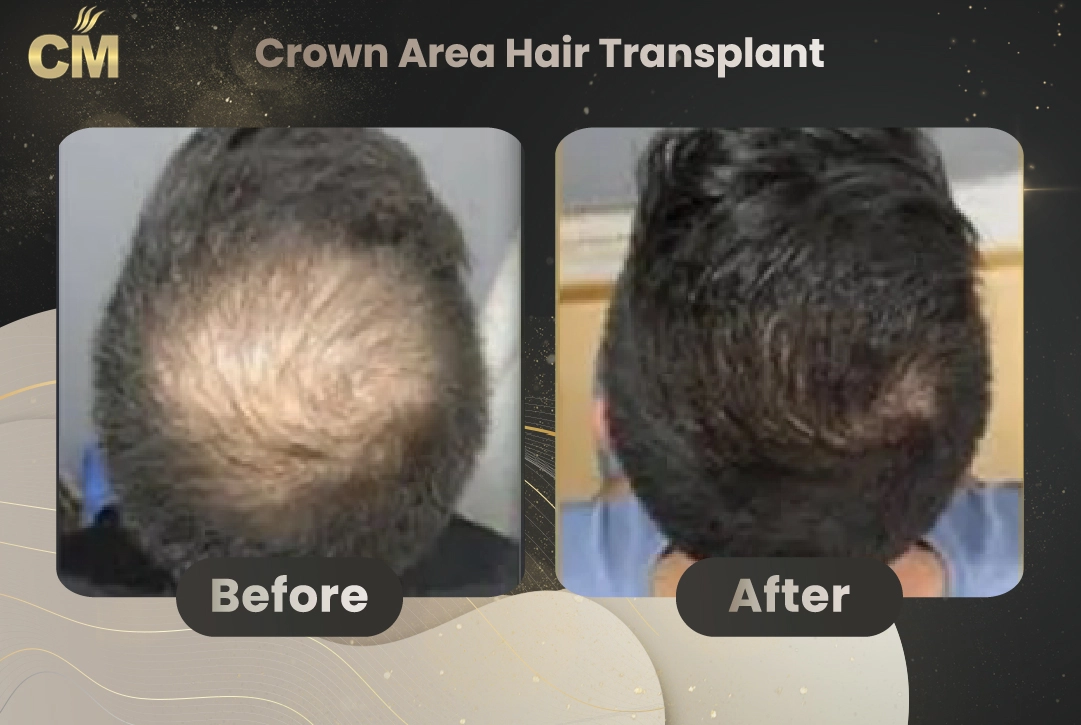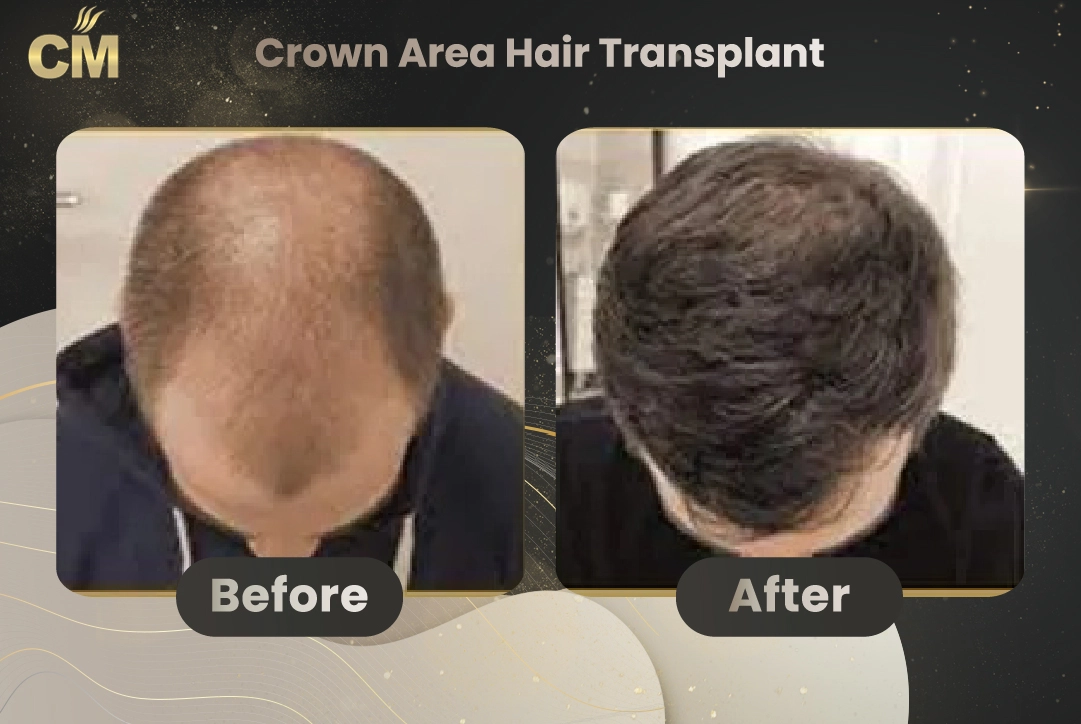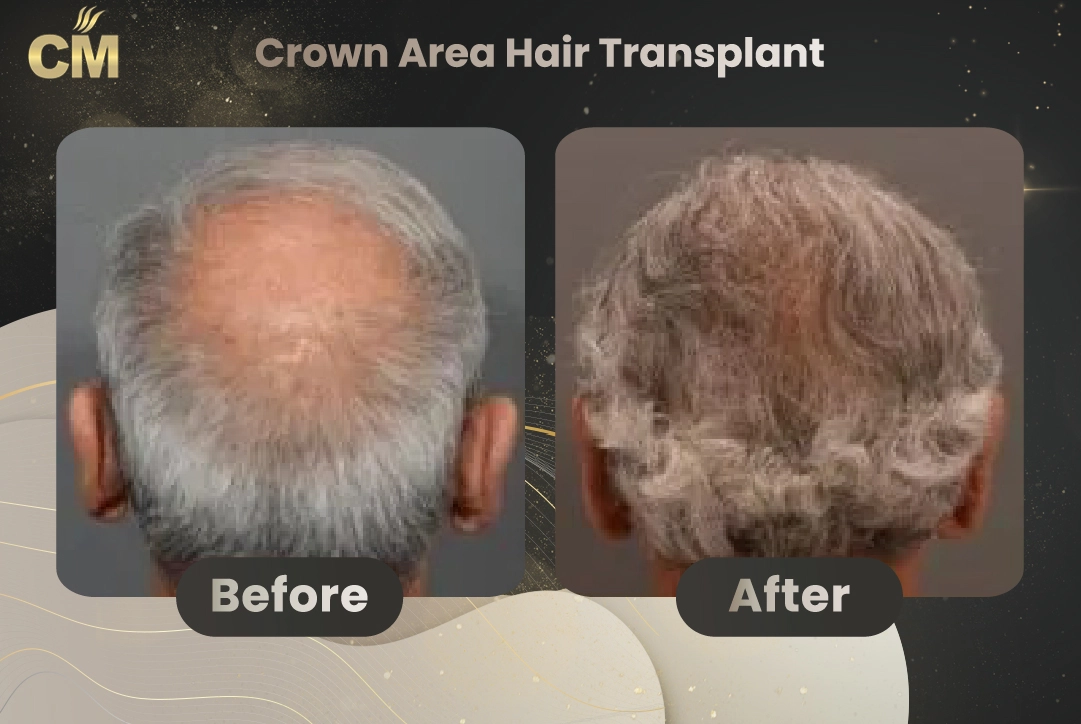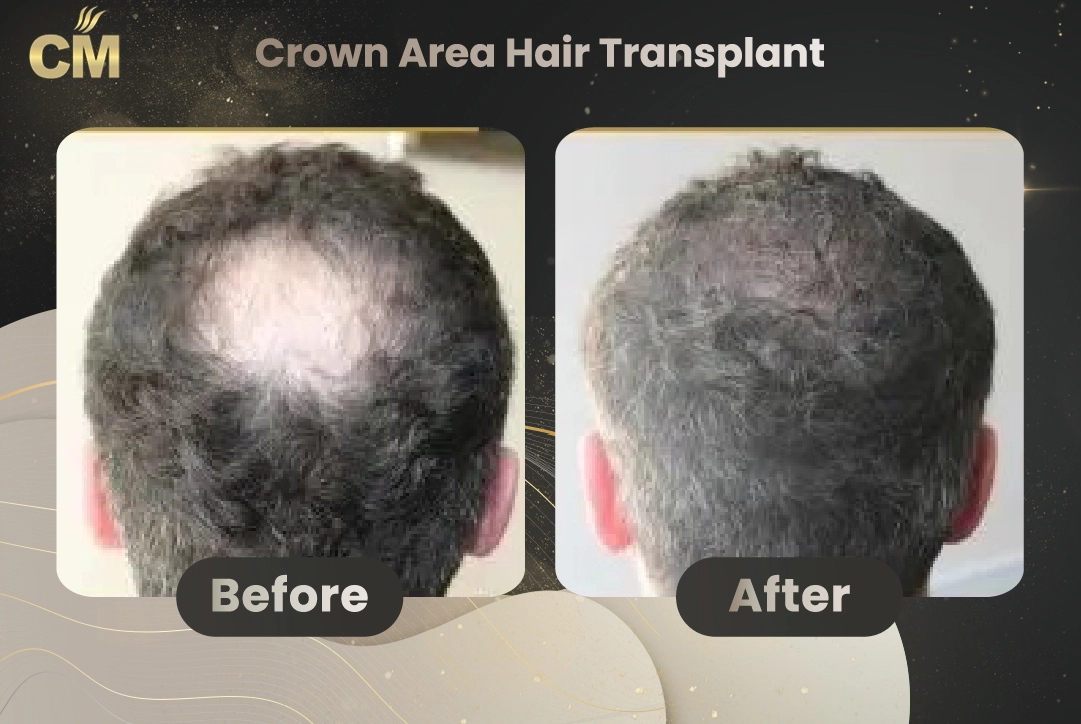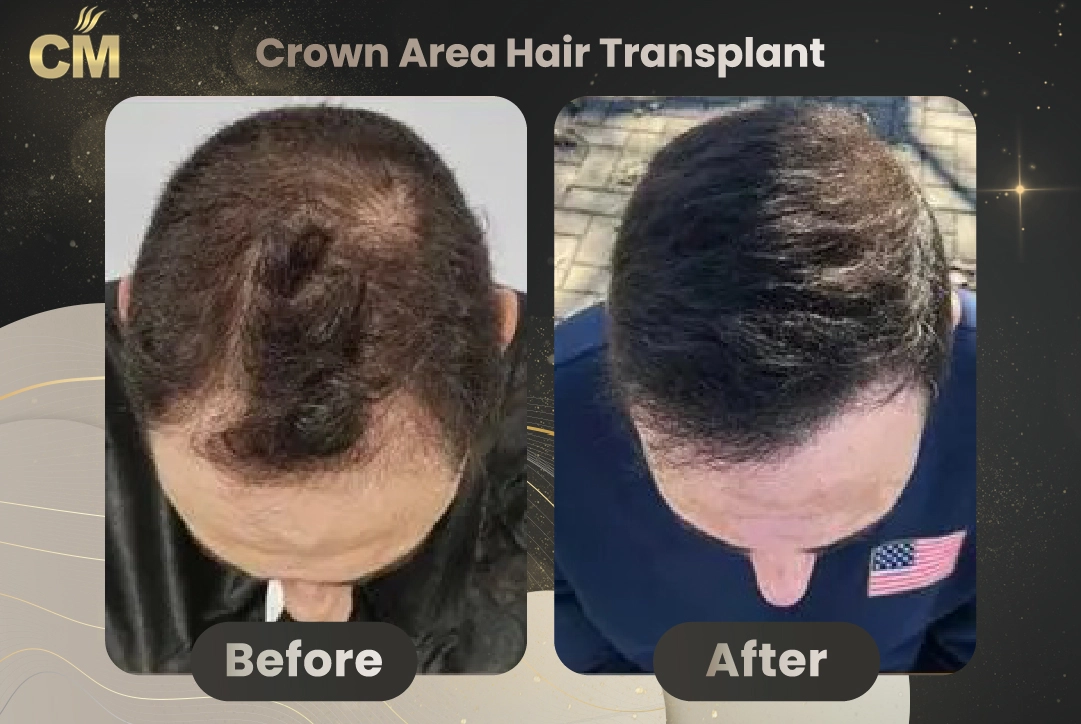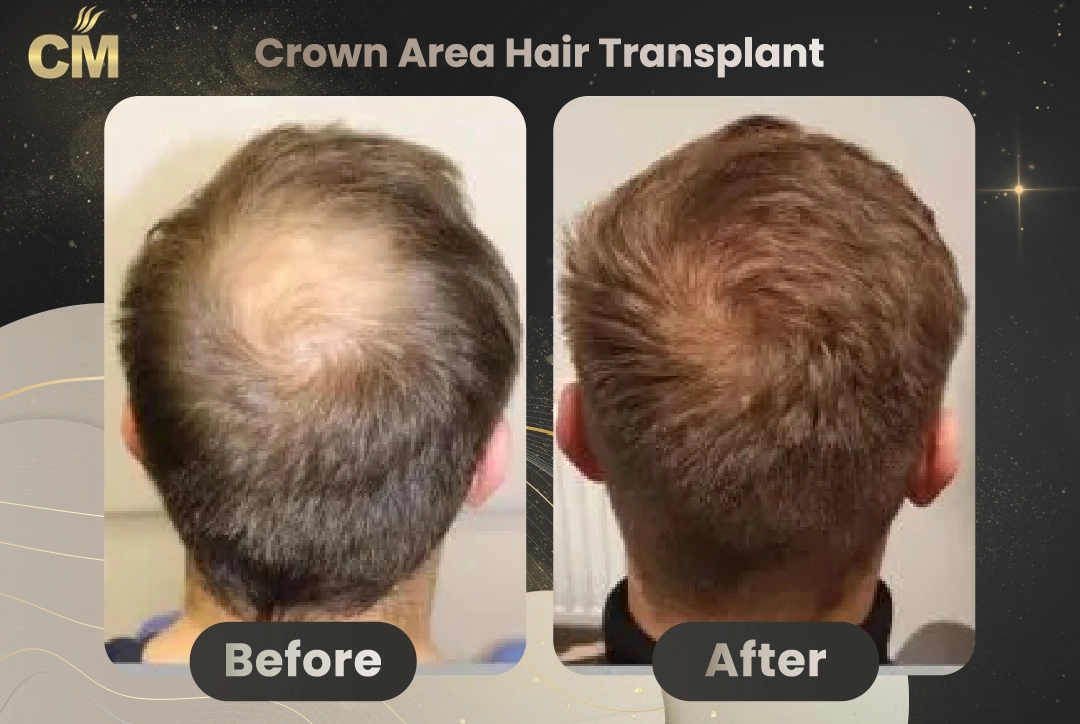A crown hair transplant is a specialized procedure that targets hair loss at the crown of the head, which is a common area where individuals experience thinning or balding. The crown, also known as the vertex, is one of the trickiest areas for hair transplantation due to its unique hair growth pattern. For those considering a crown hair transplant in Turkey,
This article provides not only pictures of the results of crown hair transplant operations but also detailed information on how the procedure is performed, as well as what to expect before and after the procedure. Additionally, this guide covers the recovery process, post-surgery care, essential travel tips, and the final results, offering a comprehensive understanding of the entire process.
Hair Loss in the Crown
Hair loss in the crown area is a common concern, affecting individuals of all genders but most frequently observed in those with male pattern baldness. Fortunately, Crown Hair Transplant In Turkey offer a transformative solution to restore a natural and youthful appearance.
Why Turkey for Crown Hair Transplants?
Turkey has emerged as a leading destination for hair transplants, attracting over 60,000 individuals annually from around the globe. Therefore country’s reputation is built on a combination of highly skilled surgeons, advanced techniques, affordable prices, and comprehensive care packages.
The Complexity of Crown Hair Transplants
Crown hair transplants surgery are more intricate than other hair restoration procedures due to the unique characteristics of the crown area.
Multi-Directional Hair Growth: Hair follicles in the crown grow in various directions. Consequently, surgeons must meticulously place grafts to achieve a natural look.
Weak Blood Circulation: Reduced blood flow in the crown can affect graft survival rates. Thus specialized techniques are necessary to ensure successful transplantation.
Achieving Natural Density: The crown naturally has lower hair density. Consequently replicating this natural look while ensuring optimal coverage is a key challenge.
The Crown Hair Transplant Procedure: Precision and Artistry
A successful crown hair transplant requires a combination of technical expertise and artistic skill, so The surgeon must carefully analyze the patient’s hair loss pattern, characteristics, and desired outcome.
Steps Involved in the Crown Hair Transplant Procedure
Consultation and Design: The surgeon discusses the patient’s goals, assesses their suitability, and creates a hair transplant surgery plan.
Extraction: The surgical team extracts hair follicles from the donor area, typically the back of the head, using Follicular Unit Extraction (FUE).
Implantation: The surgeon implants the grafts in the crown area, ensuring they follow the natural hair growth pattern and proper angulation.
Preparation and Aftercare: Key to Successful Results
Proper preparation and post-operative care are crucial for optimal crown hair transplant outcomes:
- Pre-Procedure: Patients may be advised to avoid certain medications and supplements and follow specific instructions provided by their surgeon.
- Post-Procedure: Following the surgeon’s guidelines for wound care, medication, and avoiding strenuous activities is essential for healing and graft survival.
Crown Hair Transplant Costs in Turkey
The cost of crown hair transplants in Turkey can vary based on several factors, including:
- Clinic reputation: Established and reputable clinics may charge higher fees.
- Surgeon’s experience: Highly experienced surgeons specializing may command higher prices.
- Package inclusions: Many clinics offer comprehensive packages that include accommodation, transportation, and post-operative care, influencing the final cost.
ClinMedica: Your Partner in Hair Restoration
ClinMedica, with nine years of experience in hair transplantation services, That leading clinic in Turkey renowned for its expertise and commitment to patient satisfaction. Our team of skilled surgeons specializes, utilizing advanced treatment techniques and personalized care to deliver natural-looking and long-lasting results.
Recovery Process
What to Expect After a Crown Hair Transplant
The recovery process for a crown hair transplant is similar to other types of hair transplants. In the first few days, patients may experience redness, swelling, or mild discomfort in both the donor and recipient areas. The newly transplanted follicles will form scabs that usually fall off within 7–10 days. Most patients can return to work and light activities within 3–5 days, but full recovery, including hair growth, takes several months. It’s important to avoid touching the scalp or disturbing the grafts during the initial recovery period.
Resuming Physical Activities After Surgery
While light activities, such as walking, can be resumed almost immediately after surgery, patients should avoid strenuous activities for at least two weeks. Sports, heavy lifting, or anything that causes sweating can interfere with the healing process and disrupt the newly transplanted follicles. After two weeks, patients can gradually resume their normal workout routine. Your surgeon will provide specific guidance on when it’s safe to return to full physical activities.
Maintaining the Results of a Crown Hair Transplant
To maintain the results of a crown hair transplant, it’s essential to follow your surgeon’s aftercare instructions and maintain a healthy lifestyle. Using hair growth-promoting products, such as specialized shampoos and serums, can help enhance the growth of the transplanted hair. A balanced diet and avoiding stress, smoking, and excessive alcohol consumption will also contribute to long-term success.
Scarring After a Crown Hair Transplant
Crown hair transplants typically leave minimal scarring, especially when advanced techniques such as FUE (Follicular Unit Extraction) or DHI (Direct Hair Implantation) are used. These techniques involve the extraction of individual hair follicles, leaving tiny puncture marks that heal without noticeable scarring. With proper care, any minor scarring will fade over time, making the results appear natural.
Understanding the Risks of a Crown Hair Transplant
As with any surgical procedure, there are some risks involved in crown hair transplants, such as infection, poor graft survival, or shock loss (temporary hair loss). Choosing an experienced surgeon at ClinMedica can help minimize these risks. By following the post-operative care instructions closely and attending follow-up appointments, patients can significantly reduce the likelihood of complications.
Benefits of a Crown Hair Transplant
The primary benefit of a crown hair transplant is the restoration of hair density in the crown area, leading to a fuller, more balanced head of hair. This procedure can dramatically improve the appearance of hair loss and boost self-confidence. Additionally, a successful transplant provides long-lasting results, as the transplanted hair will continue to grow naturally for the rest of your life.
Who Is Not a Suitable Candidate for a Crown Hair Transplant?
Not everyone is an ideal candidate for a crown hair transplant. Patients with insufficient donor hair, unrealistic expectations, or certain medical conditions such as uncontrolled diabetes or autoimmune disorders may not be suitable candidates. Additionally, individuals with advanced hair loss in multiple areas may need a more comprehensive approach. A consultation with a ClinMedica surgeon will help determine if a crown hair transplant is the right solution for you.
Things to Do After a Crown Hair Transplant
Key Post-Operative Care Steps
Following your surgeon’s post-operative care instructions is crucial to ensure optimal results. This includes keeping the scalp clean and avoiding touching or scratching the transplant area. You may be prescribed medicated shampoos or topical treatments to support healing. Proper hydration, nutrition, and gentle care of the scalp will contribute to a successful recovery and encourage healthy hair growth.
Things to Avoid During Recovery
During the recovery period, avoid activities that can interfere with the healing process, such as smoking, drinking alcohol, or engaging in strenuous exercise. Do not expose the scalp to direct sunlight or harsh chemicals for at least two weeks. Avoid wearing hats or helmets during the first few days, as these can disturb the newly transplanted follicles.
How Long Should You Stay in Istanbul for the Procedure?
For international patients traveling to Turkey for a crown hair transplant, it is recommended to stay in Istanbul for at least 2–3 days. This allows enough time for the procedure and follow-up consultations to ensure the scalp is healing properly before you return home.
How Many Nights Will You Stay in the Hospital?
Crown hair transplants are typically performed as outpatient procedures, meaning there is no need for an overnight stay in the hospital. Most patients can leave the clinic on the same day and continue their recovery at their accommodation. A follow-up appointment within a few days is usually required to monitor healing.
Pre-Procedure Instructions for International Patients
If you are traveling to Turkey for a crown hair transplant, it is important to prepare in advance:
- Medical Preparation: Complete any necessary medical tests and provide your surgeon with a detailed medical history, including medications and supplements you are taking.
- Packing: Bring loose, comfortable clothing and a hat to protect the scalp post-surgery.
- Flexible Flight Plans: Arrange flexible flight options in case your recovery takes longer than expected.
- Documentation: Carry all relevant medical records, including test results and surgical clearances from your healthcare provider.
Do You Need a Companion for the Procedure?
While a companion is not required for a crown hair transplant, having someone with you can be helpful, especially for support during the first day of recovery. If traveling alone, consider arranging post-operative care at your accommodation to ensure you have assistance with daily tasks during the initial healing period.
Post-Surgery Instructions
What Should You Do After a Crown Hair Transplant?
Your surgeon will provide detailed post-surgery instructions, including how to care for the transplant area and manage discomfort. It’s important to avoid washing your scalp for the first few days and follow all aftercare recommendations closely. Attend all follow-up appointments to monitor your progress and ensure the best possible outcome.
Traveling Home After Surgery
Guidelines for Airport and In-Flight Care
If you’re flying home after a crown hair transplant in Turkey, particularly on a long-haul flight, follow these guidelines:
- Timing Your Flight
Plan to stay in Istanbul for at least 3–5 days after surgery to allow for initial healing and a follow-up check before flying home. - In-Flight Care
During the flight:- Stay Hydrated: Drink plenty of water to prevent dehydration and support healing.
- Avoid Touching Your Scalp: Keep your hands away from the transplant area to avoid disturbing the grafts.
- Wear Comfortable Clothing: Choose loose, comfortable clothing to avoid pressure on the scalp.
- Pain Management: Carry any prescribed pain medications in your carry-on luggage and take them as directed.
- Airport Assistance
Navigating the airport post-surgery can be tiring, so consider requesting assistance, such as help with luggage or a wheelchair, to avoid overexertion. Avoid lifting heavy bags or anything that could strain your arms or shoulders. - Long-Haul Flight Considerations
For long-distance travel, take frequent breaks to stretch and move around to maintain circulation. Plan for additional rest days once you return home to allow your body to continue healing.
By following these post-surgery and travel guidelines, you can ensure a smooth recovery and a safe journey home after your crown hair transplant. ClinMedica provides comprehensive care instructions to help you achieve the best possible results.
When Will You See the Final Results?
The final results of a crown hair transplant take time to fully develop. In the first few weeks, the transplanted hair may shed, which is a normal part of the hair growth cycle. New hair growth typically starts around 3–4 months post-surgery, with full results visible after 9–12 months. The transplanted hair will continue to grow naturally for the rest of your life, providing a long-term solution to hair loss in the crown area.
